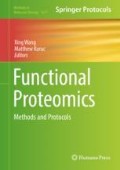Abstract
Targeted proteomics detects proteins of interest with high sensitivity, quantitative accuracy, and reproducibility. In a targeted proteomics assay, surrogate peptides are generated by proteolytic digestion of target proteins and selected reaction monitoring (SRM) assays are developed to quantify these peptides using liquid chromatography-tandem mass spectrometry (LC-MS/MS). In this report, we describe the details of quantitative analysis of target protein in cells and tissue samples.
Access this chapter
Tax calculation will be finalised at checkout
Purchases are for personal use only
References
Yocum AK, Chinnaiyan AM (2009) Current affairs in quantitative targeted proteomics: multiple reaction monitoring–mass spectrometry. Brief Funct Genomics Proteomics 8(2):145–157
Pan S, Aebersold R, Chen R, Rush J, Goodlett DR, McIntosh MW, Zhang J, Brentnall TA (2008) Mass spectrometry based targeted protein quantification: methods and applications. J Proteome Res 8(2):787–797
Parker CE, Pearson TW, Anderson NL, Borchers CH (2010) Mass-spectrometry-based clinical proteomics–a review and prospective. Analyst 135(8):1830–1838
Domon B, Aebersold R (2006) Mass spectrometry and protein analysis. Science 312(5771):212–217
Marx V (2013) Targeted proteomics. Nat Methods 10(1):19–22
Doerr A (2010) Targeted proteomics. Nat Methods 7(1):34–34
Doerr A (2013) Mass spectrometry-based targeted proteomics. Nat Methods 10(1):23–23
Yang T, Xu F, Xu J, Fang D, Yu Y, Chen Y (2013) Comparison of liquid chromatography–tandem mass spectrometry-based targeted proteomics and conventional analytical methods for the determination of P-glycoprotein in human breast cancer cells. J Chromatogr B 936:18–24
Yang T, Chen F, Xu F, Wang F, Xu Q, Chen Y (2014) A liquid chromatography–tandem mass spectrometry-based targeted proteomics assay for monitoring P-glycoprotein levels in human breast tissue. Clin Chim Acta 436:283–289
Yu Y, Xu J, Liu Y, Chen Y (2012) Quantification of human serum transferrin using liquid chromatography–tandem mass spectrometry based targeted proteomics. J Chromatogr B 902:10–15
Yang T, Xu F, Zhao Y, Wang S, Yang M, Chen Y (2014) A liquid chromatography-tandem mass spectrometry-based targeted proteomics approach for the assessment of transferrin receptor levels in breast cancer. Proteom Clin Appl 8(9–10):773–782
Yang T, Xu F, Fang D, Chen Y (2015) Targeted proteomics enables simultaneous quantification of folate receptor isoforms and potential isoform-based diagnosis in breast cancer. Sci Rep 5:16733
Yang T, Xu F, Sheng Y, Zhang W, Chen Y (2016) A targeted proteomics approach to the quantitative analysis of ERK/Bcl-2-mediated anti-apoptosis and multi-drug resistance in breast cancer. Anal Bioanal Chem 408(26):7491–7503
Zhang W, Zhong T, Chen Y (2017) LC-MS/MS-based targeted proteomics quantitatively detects the interaction between p53 and MDM2 in breast cancer. J Proteome 152:172–180
Xu F, Yang T, Fang D, Xu Q, Chen Y (2014) An investigation of heat shock protein 27 and P-glycoprotein mediated multi-drug resistance in breast cancer using liquid chromatography-tandem mass spectrometry-based targeted proteomics. J Proteome 108:188–197
Anderson L, Hunter CL (2006) Quantitative mass spectrometric multiple reaction monitoring assays for major plasma proteins. Mol Cell Proteomics 5(4):573–588
Prakash A, Tomazela DM, Frewen B, MacLean B, Merrihew G, Peterman S, MacCoss MJ (2009) Expediting the development of targeted SRM assays: using data from shotgun proteomics to automate method development. J Proteome Res 8(6):2733–2739
Picotti P, Aebersold R (2012) Selected reaction monitoring-based proteomics: workflows, potential, pitfalls and future directions. Nat Methods 9(6):555–566
Gianazza E, Tremoli E, Banfi C (2014) The selected reaction monitoring/multiple reaction monitoring-based mass spectrometry approach for the accurate quantitation of proteins: clinical applications in the cardiovascular diseases. Expert Rev Proteomics 11(6):771–788
Schmidt C, Urlaub H (2012) Absolute quantification of proteins using standard peptides and multiple reaction monitoring. Methods Mol Biol 893:249–265
Dillen L, Cools W, Vereyken L, Lorreyne W, Huybrechts T, de Vries R, Ghobarah H, Cuyckens F (2012) Comparison of triple quadrupole and high-resolution TOF-MS for quantification of peptides. Bioanalysis 4(5):565–579
Mosby I (2006) Mosby's medical dictionary. Mosby
Zolotarjova N, Martosella J, Nicol G, Bailey J, Boyes BE, Barrett WC (2005) Differences among techniques for high-abundant protein depletion. Proteomics 5(13):3304–3313
Author information
Authors and Affiliations
Corresponding author
Editor information
Editors and Affiliations
Rights and permissions
Copyright information
© 2019 Springer Science+Business Media, LLC, part of Springer Nature
About this protocol
Cite this protocol
Chen, Y., Liu, L. (2019). Targeted Proteomics. In: Wang, X., Kuruc, M. (eds) Functional Proteomics. Methods in Molecular Biology, vol 1871. Humana Press, New York, NY. https://doi.org/10.1007/978-1-4939-8814-3_17
Download citation
DOI: https://doi.org/10.1007/978-1-4939-8814-3_17
Published:
Publisher Name: Humana Press, New York, NY
Print ISBN: 978-1-4939-8813-6
Online ISBN: 978-1-4939-8814-3
eBook Packages: Springer Protocols

